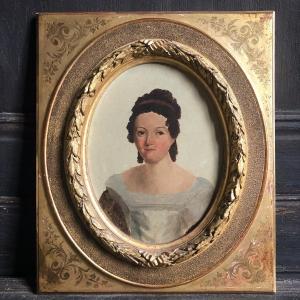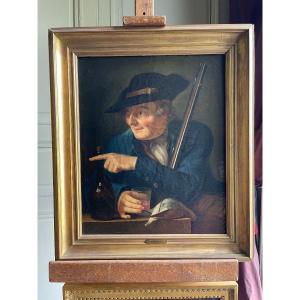Napoleon Bonaparte, First Consul
Between 1799 et 1804
Oil on canvas
Titled at the bottom “BUONAPARTE” (slightly faded)
72,5 x 60,5 cm
The First Consul Napoleon Bonaparte is depicted in a profile bust by the painter Piat-Joseph Sauvage. Piat Joseph Sauvage (1744-1818), a student at the Academy of Tournai where he was born, went on to perfect his education at the Royal Academy of Fine Arts in Antwerp under the direction of the history and grisaille painter Martin-Joseph Geeraerts. He moved to Paris in 1774 and became a member of the Academy of Saint-Luc. First painter to Louis-Joseph de Bourbon, Prince of Condé in 1780, then to King Louis XVI, he was admitted to the Royal Academy of Painting and Sculpture in 1781 (received in 1783). From then on, he exhibited regularly at the Salon until 1804. From 1797 to 1804, he worked for the Parisian porcelain manufactory Dilh et Guérhard and from 1804 to 1807 for the Sèvres manufactory. In 1808, he returned to Tournai to take over the direction of the Académie de dessin, a city in which he died in 1818. Piat Joseph Sauvage specialized in the imitation of marble and ancient terracotta. His trompe-l'oeil imitations of ancient bas-reliefs still adorn certain castles around Paris, such as the palaces of Versailles, Fontainebleau and Compiègne, as well as the Queen's dairy in Rambouillet. In our trompe-l'oeil (the term trompe-l'oeil, which plays with the viewer's gaze, was first used by Louis Léopold Boilly (1761-1845) in the caption of a work exhibited at the Salon of 1800), the painter depicts Bonaparte's profile bust after the coup d'état of 18-19 Brumaire, Year VIII. Sauvage uses a pictorial genre - trompe-l'oeil - often dedicated to still lifes such as Vanities or Hunting Trophies, to imitate here a bas-relief sculpture on a flat image. The profile bust of the First Consul stands out clearly against a blue background with attention to detail. Bonaparte is dressed in the double-breasted consular habit, adorned with embroidered laurel leaves and oak leaves. His neck is tightened in a cravat, the collar turned up, and the locks of his short hair are pulled back over his forehead. The impassive features of the future emperor's face are regular, with a hooked nose and well-defined lips, while his gaze is determined like that of a heroic figure. The careful arrangement of light and shadow contributes to the illusion of the bas-relief.
Related works
- Portrait of Bonaparte First Consul, Piat-Joseph Sauvage (Tournai, 1744 - Tournai, 1818), between 1799 and 1804, Musée Carnavalet, Histoire de Paris, P838
Literature
Émile Bellier de laChavignerie, « Les artistes français du XVIIIe siècle oubliés ou dédaignés :188-Sauvage (Piat-Joseph) », Revue universelle des arts, t. 21,1865, p. 99-100
M. et F. Faré, La viesilencieuse en France. La nature morte au XVIIIe siècle, Fribourg, 1976, p.276-285
Collectif, Le trompe-l’œil,de 1520 à nos jours, musée Marmottan-Monet, Snoeck Publishers, 2024

















 Le Magazine de PROANTIC
Le Magazine de PROANTIC TRÉSORS Magazine
TRÉSORS Magazine Rivista Artiquariato
Rivista Artiquariato